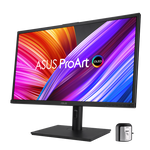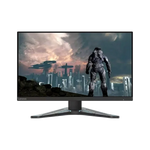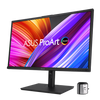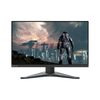A comparison of specs, key information, reviews, and best pricing from top retailers
Last updated -- hours ago | Report incorrect information
What we think

The PerfectRec monitor team Learn more
Updated April 11, 2024·
If you prioritize high-quality visuals for tasks like HDR gaming and photo editing, the Asus PA27DCE may justify its premium price with its exceptional color depth, contrast, and image clarity. However, it is not well-suited for competitive gaming due to its lower refresh rate. On the other hand, the Lenovo G24-20 offers good gaming performance and is cost-effective, but it won't match the Asus in visual fidelity or for color-sensitive work. Choose the Asus for top-tier visual tasks and the Lenovo if you're looking for a budget-friendly option with decent gaming experience and general productivity. Give Feedback
this description is based on the product variant with some specs and product variant with some specs. At the time of writing, the variant with some specs cost some dollars and the variant with some specs cost some dollars.
Advantages of the Asus PA27DCE (W-OLED)
- Best in class for casual gaming
- Very good for media consumption
- Very good image clarity
- Best in class contrast
- Best in class response time
Advantages of the Lenovo G24-20 (IPS)
- Good refresh rate
Key differences
Casual Gaming
9.6


5.7
3840 x 2160
RESOLUTION
1920 x 1080
60Hz
REFRESH RATE
165Hz
Inf:1
NATIVE CONTRAST
1000:1
200 nits
SDR PEAK BRIGHTNESS
300 nits
Unknown
HDR PEAK BRIGHTNESS
99.0 %
DCI-P3 COLOR GAMUT
N/A
Matte
COATING
Matte
The Asus PA27DCE (W-OLED) is best in class for casual gaming, while the Lenovo G24-20 (IPS) is poor.
Productivity
6.6


4.9
3840 x 2160
RESOLUTION
1920 x 1080
163 PPI
PIXELS PER INCH
92 PPI
Yes
ADJUSTABLE STAND
Yes
Matte
COATING
Matte
The Asus PA27DCE (W-OLED) is only fair for productivity, while the Lenovo G24-20 (IPS) is poor.
Media Consumption
8.4


5.4
3840 x 2160
RESOLUTION
1920 x 1080
Inf:1
NATIVE CONTRAST
1000:1
200 nits
SDR PEAK BRIGHTNESS
300 nits
Unknown
HDR PEAK BRIGHTNESS
Matte
COATING
Matte
The Asus PA27DCE (W-OLED) is very good for media consumption, while the Lenovo G24-20 (IPS) is poor.
Cost
$1,999


$195
$0
$500
$1,000
$1,500
$2,000
$2,500
$3,000
The Asus PA27DCE (W-OLED) has a price of $1,999 and the Lenovo G24-20 (IPS) costs $195.
HDR Gaming and Media Consumption
Yes


No
The Asus PA27DCE (W-OLED) is suitable for HDR gaming and media consumption while the Lenovo G24-20 (IPS) is not suitable for HDR gaming and media consumption.
Digital Photo Editing
Yes


No
The Asus PA27DCE (W-OLED) is suitable for digital photo editing while the Lenovo G24-20 (IPS) is not suitable for digital photo editing.
Key similarities
Competitive Gaming
5.8


5.7
60Hz
REFRESH RATE
165Hz
0.1 ms
TOTAL RESPONSE TIME
8.0 ms
N/A
VARIABLE REFRESH RATE
48 - 165 Hz
No
STROBING / BFI
No
200 nits
SDR PEAK BRIGHTNESS
300 nits
The Asus PA27DCE (W-OLED) and Lenovo G24-20 (IPS) are both poor for competitive gaming.
HDR Video Editing and Color Grading
No


No
Both the Asus PA27DCE (W-OLED) and Lenovo G24-20 (IPS) are not suitable for HDR video editing and color grading.
Print Photo Editing
Yes


Yes
Both the Asus PA27DCE (W-OLED) and Lenovo G24-20 (IPS) are suitable for print photo editing.
Give feedback
We’re constantly working to improve.
How the Asus PA27DCE (W-OLED) and the Lenovo G24-20 (IPS) compare to other monitors
Spec Comparison
| Asus PA27DCE (W-OLED) | Lenovo G24-20 (IPS) |
GENERAL | |||
|---|---|---|---|
| Price | |||
$1,999 | $195 | ||
Screen Size | |||
Screen Size | 27" | 24" | |
Resolution | |||
Resolution | 3840 x 2160 | 1920 x 1080 | |
Screen Type | |||
Screen Type | OLED | LED | |
Screen Sub-type | |||
Screen Sub-type | W-OLED | IPS | |
Refresh Rate | |||
Refresh Rate | 60Hz | 165Hz | |
COLOR, CONTRAST & BRIGHTNESS | |||
|---|---|---|---|
Native Contrast | |||
Native Contrast | Inf:1 | 1000:1 | |
SDR Peak Brightness | |||
SDR Peak Brightness | 200 nits | 300 nits | |
HDR Peak Brightness | |||
HDR Peak Brightness | Unknown | ||
Suitable for HDR Gaming and Media Consumption | |||
Suitable for HDR Gaming and Media Consumption | Yes | No | |
sRGB Color Gamut | |||
sRGB Color Gamut | 100 % | 99 % | |
MOTION CHARACTERISTICS | |||
|---|---|---|---|
Total Response Time | |||
Total Response Time | 0.1 ms | 8 ms | |
Variable Refresh Rate | |||
Variable Refresh Rate | N/A | 48 - 165 Hz | |
Strobing / BFI | |||
Strobing / BFI | No | No | |
Persistence Blur Score | |||
Persistence Blur Score | 5/10 | 7.1/10 | |
Ghosting Score | |||
Ghosting Score | 10/10 | 7.6/10 | |
TEXT & IMAGE CLARITY | |||
|---|---|---|---|
Pixels Per Inch | |||
Pixels Per Inch | 163 PPI | 92 PPI | |
Coating | |||
Coating | Matte | Matte | |
Text Clarity Score | |||
Text Clarity Score | 6.9/10 | 6.2/10 | |
Image Clarity Score | |||
Image Clarity Score | 8/10 | 6.2/10 | |
PORTS & CONNECTIVITY | |||
|---|---|---|---|
HDMI 1.4 Ports | |||
HDMI 1.4 Ports | 0 | 0 | |
HDMI 2.0 Ports | |||
HDMI 2.0 Ports | 3 | 2 | |
HDMI 2.1 Ports | |||
HDMI 2.1 Ports | 0 | 0 | |
Micro HDMI Ports | |||
Micro HDMI Ports | 0 | 0 | |
DisplayPort 1.2 Ports | |||
DisplayPort 1.2 Ports | 0 | 0 | |
Give feedback
We're constantly perfecting our model
More comparisons for you
Compare Asus PA27DCE (W-OLED) vs. LG 27EQ850 (W-OLED)
VS
Compare Asus PA27DCE (W-OLED) vs. LG 45GR95QE (W-OLED)
VS
Compare Asus PA27DCE (W-OLED) vs. Corsair 45WQHD240 (W-OLED)
VS
Compare Lenovo G24-20 (IPS) vs. KTC H27T22 (IPS)
VS
Compare Lenovo G24-20 (IPS) vs. Dell S2721QS (IPS)
VS
Compare Lenovo G24-20 (IPS) vs. MSI G273QPF (IPS)
VS
FAQs
Why trust us
This information was produced and vetted by the PerfectRec monitors team. We are a product research and recommendation organization that meticulously reviews and evaluates the latest monitor information and makes it digestible for you.
By the numbers
210
Monitors evaluated
10,500
Monitors stats compiled
15
Proprietary Monitors ratings developed
117,200
Recommendations made
17,580
Consumer hours saved
About the monitor team
Joe Golden, Ph.D
CEO and Monitors Editor
Joe is an entrepreneur and lifelong electronics enthusiast with a Ph.D in Economics from the University of Michigan.
Jason Lew
Staff Expert & Software Engineer
Jason is a staff expert and software engineer that has been making laptop recommendations for 7 years and moderates one of the largest laptop subreddits.
Chandradeep Chowdhury
Staff Expert & Software Engineer
Chandradeep is a staff expert and software engineer and expert in televisions and monitors. He’s been making monitor recommendations for ten years.







